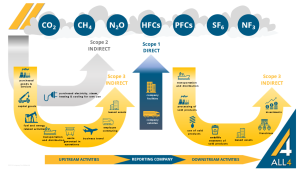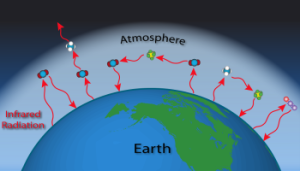Scope 1 & 2, and Sometimes Scope 3 GHG Emissions Disclosures Are Becoming Required for Many Market Actors
Posted: May 17th, 2023
Authors: Connie P.Here are some answers to questions we hear the most from our clients.
What does Scope 1, 2 & 3 mean?
The GHG Protocol was developed by World Resources Institute (WRI) and the World Business Council for Sustainable Development (WBCSD) to “establish comprehensive global standardized frameworks to measure and manage greenhouse gas (GHG) emissions from private and public sector operations, value chains and mitigation actions”.
The GHG Protocol categorizes GHG emissions thusly:
Scope 1 Direct GHG Emissions
Direct GHG emissions occur from sources that are owned or controlled by an organization. These emissions are a result of activities or processes that release GHGs into the atmosphere such as emissions from combustion in owned or controlled boilers, furnaces, vehicles, etc., and emissions from chemical production in owned or controlled process equipment. This also includes company vehicles or unintentional releases of GHGs such as leaks or flares.
Scope 2 Utility Indirect GHG Emissions
Indirect GHG emissions from the generation of electricity, heat or steam purchased by or otherwise brought into the organizational boundary of an organization. Scope 2 emissions physically occur at the facility where electricity is generated, such as a power plant owned by your utility provider. Your Scope 2 emissions are Scope 1 emissions for your utility provider.
Scope 3 Other Indirect GHG emissions
Other Indirect GHG emissions that occur throughout an organization’s supply chain are categorized as Scope 3. These include upstream and downstream GHG emissions which are a consequence of the activities or products of the company but occur from sources not owned or controlled by the company. Scope 3 emissions are typically the largest and most complex category to measure and manage. Examples of Scope 3 GHG emissions include purchased goods and services, upstream transportation and distribution, waste disposal and treatment, business travel and employee commuting.
The following chemical compounds are considered GHG’s according to the GHG Protocol and the Kyoto Protocol:
Carbon Dioxide – CO2
Sulfur Hexafluoride – SF6
Methane – CH4
Nitrous Oxide – N2O
Hydrofluorocarbons – HFCs
Perfluorocarbons – PFCs
Nitrogen Trifluoride – NF3
Other greenhouse species, which are produced in smaller quantities, or which have lower global warming potential (GWP), such as water, some VOCs or NOX are not typically required for Scope 1,2 & 3 disclosures.
Figure 1 Scope 1,2 3 Emissions – GHG Protocol
What makes a molecule a greenhouse gas?
If you want to find the secrets of the universe, think in terms of energy, frequency and vibration – Nikola Tesla
At the risk of oversimplification greenhouse gas molecules have radiative properties, which means they absorb, hold and eventually reemit heat in the form of Infrared Radiation (IR). Solar energy enters the atmosphere at shorter wavelengths that allow the photons to pass through GHGs in the atmosphere and reach Earth’s surface. The photons are absorbed by the Earth and reflected back into the atmosphere at longer wavelengths, which correspond to the frequency at which the molecules vibrate, allowing GHG molecules to trap the heat for a while.
Without the greenhouse effect human life could not survive on earth. However, the more molecules with radiative properties the more heat is trapped in the atmosphere, causing an enhanced greenhouse effect leading to global warming. The concentration of CO2 in the atmosphere has increased nearly 150% since the Industrial Revolution.
Figure 2 NOAA Global Monitoring Lab
I report according to 40 CFR Part 98. Do I need to do more for Scope 1, 2 & 3?
Yes. Part 98, aka EPA Greenhouse Gas Reporting Program Mandatory Greenhouse Gas Reporting Rule includes only a subset of Scope 1, direct emissions. There are other direct emissions, such as mobile sources, which need to be captured for Scope 1. Scopes 2 & 3 are not covered at all by Part 98 reporting obligations.
Why would I need to disclose GHG emissions if there is not a compliance obligation?
Depending on the locations of your facilities and your emissions rates, you may be subject to compliance obligations now or soon. Aside from the EPA regulation, which is triggered by GHG emissions more than 25,000 tons, currently 24 states and the District of Columbia have GHG emissions targets. California and Washington state have broad GHG cap and trade programs (WA’s Cap and Invest legislation takes effect this year) and 11 states in the Regional Greenhouse Gas Initiative have cap and trade programs for the power sector.
Even if you aren’t subject to state or federal laws, there may be market access requirements or other stakeholder pressures to disclose. For example:
- It is anticipated that the SEC will release rules on GHG emissions disclosure for issuers this summer. This will mean that companies whose stocks trade on US exchanges will need to disclose at least Scope 1 and 2 emissions. How the final rules play out – for example the role of Scope 3 disclosures, is yet to be seen.
- If you do more the €150m annually of business in the EU, you may be subject to CSRD disclosure requirements.
- Many large companies such as Walmart, Microsoft and Nike are part of the CDP Supply Chain Program and so require certain suppliers to disclose to CDP. The CDP Supply Chain Program has over 280 members with combined $6.4 trillion in purchasing power. The program resulted in 40,000 requests to suppliers for CDP disclosure.
- GSA policy adopted in January 2023 offers 3,500 points for emission disclosures, out of the 94,700 maximum points available for government wide IT contracts. The 60 suppliers with the highest number of points overall will receive the contracts.
- $7.5 million from the federal government to inventory and disclose greenhouse gas emissions from their own operations and from the energy they use — known as Scope 1 and 2 emissions. The same rule would create additional requirements for companies with contracts totaling $50 million or more. Those “major” contractors would have to tally and report emissions from their suppliers, known as Scope 3 emissions. The proposed rule would also require them to develop net-zero emissions goals that align with the temperature goals of the Paris Agreement, and to get those goals validated by a voluntary scientific integrity body known as the Science-Based Targets initiative.
When would I need to get started?
It depends on what your stakeholder’s requirements are, or your regulatory obligations, or SEC or Fed procurement final rules, but the sooner the better. Developing a baseline inventory from scratch, or even with Part 98 data as a starting point, can take several weeks to several months depending on complexity, data availability, people availability and other factors.
Now that I have a baseline, what next?
Once your baseline year is established you should leverage the momentum to calculate all years forward from baseline for which you have data. This will be helpful for identifying trends and anomalies, revealing inconsistencies, setting goals, identifying performance paths and meeting stakeholder requirements for current data.
We are a privately held company, so the SEC and EU requirements don’t apply to us, right?
The SEC rules will not directly apply to companies which are not traded on US exchanges. However, if your customers are subject to the disclosure rules they may be knocking on your door. For the EU rules, at present they do include companies which do over €150m of business in the EU annually.
How can ALL4 help?
All4 is a CDP Accredited Climate Consultancy and can help you where you stand. Whether you are just getting started and need to define operational or organizational boundaries, figure out what your obligations are, or develop a baseline accounting All4’s experienced team can help. If you are further along and need to have your calculations third party verified, set reduction targets, develop a transition plan, identify climate and transition risks according to TCFD, or develop a communications strategy and transition plans, All4 can offer strategic advisory services and tactical support.
Contact: Connie Prostko-Bell, Director, ESG & Sustainability Practice, cprostko-bell@all4inc.com, 610-422-1110.
References:
Greenhouse Gas Protocol https://ghgprotocol.org/
GHG Corporate Standard https://ghgprotocol.org/corporate-standard
Part 98 https://www.ecfr.gov/current/title-40/chapter-I/subchapter-C/part-98?toc=1
SEC Climate Disclosure Rule https://www.sec.gov/rules/proposed/2022/33-11042.pdf
CDP Supply Chain Program https://www.cdp.net/en/supply-chain
Federal Supplier Climate Risks and Resilience Proposed Rule https://www.sustainability.gov/federalsustainabilityplan/fed-supplier-rule.html
NOAA Global Monitoring Laboratory https://gml.noaa.gov/ccgg/trends/



